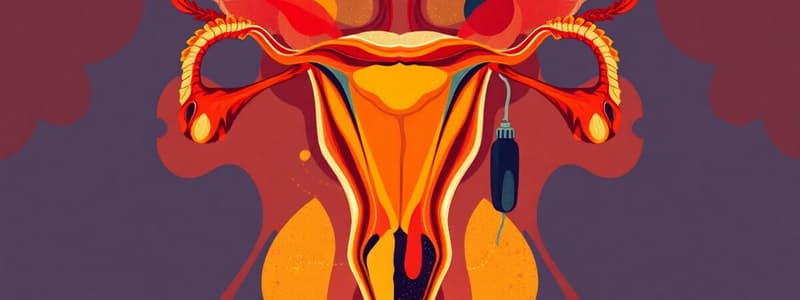Podcast
Questions and Answers
What is a key event marking puberty in males?
What is a key event marking puberty in males?
- Menarche
- Formation of sperm (correct)
- Development of secondary sexual characteristics in females
- Menstrual cycle commencement
Which hormone is primarily produced by the male gonads?
Which hormone is primarily produced by the male gonads?
- Testosterone (correct)
- Progesterone
- Estrogen
- Luteinizing hormone
How does the hormone production in males differ from that in females?
How does the hormone production in males differ from that in females?
- Males produce two types of hormones
- Males do not produce testosterone
- Males have continuous production of one type of hormone (correct)
- Males produce more hormones than females
What is the main role of gonads in both male and female genital systems?
What is the main role of gonads in both male and female genital systems?
Which statement is true regarding testosterone production?
Which statement is true regarding testosterone production?
What is the role of the seminiferous tubules in the male reproductive system?
What is the role of the seminiferous tubules in the male reproductive system?
Which structure is not involved in the transport of sperm?
Which structure is not involved in the transport of sperm?
How does testosterone production vary in the male reproductive system?
How does testosterone production vary in the male reproductive system?
Which structure connects the seminiferous tubules to the rete testis?
Which structure connects the seminiferous tubules to the rete testis?
What does the convoluted nature of the seminiferous tubules facilitate?
What does the convoluted nature of the seminiferous tubules facilitate?
What role do the testes have in the male reproductive system?
What role do the testes have in the male reproductive system?
What is the primary shape of the testis?
What is the primary shape of the testis?
Which gland is NOT mentioned as part of the male reproductive system?
Which gland is NOT mentioned as part of the male reproductive system?
What structure does the vas deferens lead into as it gathers secretions?
What structure does the vas deferens lead into as it gathers secretions?
Which of the following correctly describes the position of the testicles?
Which of the following correctly describes the position of the testicles?
Which of the following statements about the testis is false?
Which of the following statements about the testis is false?
What happens when ejaculation is occurring in the male reproductive system?
What happens when ejaculation is occurring in the male reproductive system?
What separates each testicle within the scrotum?
What separates each testicle within the scrotum?
Which statement accurately describes the function of the seminal vesicles, prostate gland, and bulbourethral glands?
Which statement accurately describes the function of the seminal vesicles, prostate gland, and bulbourethral glands?
Which structure is directly connected to the testis?
Which structure is directly connected to the testis?
What structure is formed when the convoluted tubules of the testis merge?
What structure is formed when the convoluted tubules of the testis merge?
Which structure directly follows the rete testis in the male reproductive system?
Which structure directly follows the rete testis in the male reproductive system?
What distinguishes the male reproductive system from the female reproductive system?
What distinguishes the male reproductive system from the female reproductive system?
What is the single duct formed from the efferent ducts exiting the epididymis?
What is the single duct formed from the efferent ducts exiting the epididymis?
What is the final part of the male reproductive system, which also forms part of the urinary system?
What is the final part of the male reproductive system, which also forms part of the urinary system?
What is the primary reason for the whitish color of the testicles?
What is the primary reason for the whitish color of the testicles?
Which of the following correctly describes the relationship between the testis, epididymis, and ductus deferens?
Which of the following correctly describes the relationship between the testis, epididymis, and ductus deferens?
What anatomical feature separates the two testicles?
What anatomical feature separates the two testicles?
What is the outer layer of the testicle called?
What is the outer layer of the testicle called?
Which statement regarding the connection between the testicle and scrotum is true?
Which statement regarding the connection between the testicle and scrotum is true?
What is the process by which the testicles move from the abdominal cavity to the scrotum called?
What is the process by which the testicles move from the abdominal cavity to the scrotum called?
What condition results from the failure of the testicles to descend properly?
What condition results from the failure of the testicles to descend properly?
Which membrane is crucial in covering abdominal organs and is involved in testicle descent?
Which membrane is crucial in covering abdominal organs and is involved in testicle descent?
What structure is formed from the peritoneum during the descent of the testicles?
What structure is formed from the peritoneum during the descent of the testicles?
What is the significance of the space between the outer and inner layers of covering around the testicle?
What is the significance of the space between the outer and inner layers of covering around the testicle?
What is the primary function of the visceral tunica vaginalis?
What is the primary function of the visceral tunica vaginalis?
Which of the following statements about the parietal tunica vaginalis is true?
Which of the following statements about the parietal tunica vaginalis is true?
What occurs to the connection between the abdominal cavity and the scrotum during fetal development?
What occurs to the connection between the abdominal cavity and the scrotum during fetal development?
Which layer of the tunica vaginalis is primarily associated with the testicular surface?
Which layer of the tunica vaginalis is primarily associated with the testicular surface?
What is the relationship between the peritoneum and the testicle during its migration?
What is the relationship between the peritoneum and the testicle during its migration?
What is the role of the tunica albuginea in the structure of the testicle?
What is the role of the tunica albuginea in the structure of the testicle?
Which of the following best describes the visceral layer of the serous membrane surrounding the testicle?
Which of the following best describes the visceral layer of the serous membrane surrounding the testicle?
What feature of the tunica albuginea contributes to the division of the testicle into lobules?
What feature of the tunica albuginea contributes to the division of the testicle into lobules?
In a histological section of the testicle, which structure primarily contains seminiferous tubules?
In a histological section of the testicle, which structure primarily contains seminiferous tubules?
What is the appearance of the tunica albuginea as described in the histological examination?
What is the appearance of the tunica albuginea as described in the histological examination?
What is the primary function of the seminiferous tubules within the testicular lobules?
What is the primary function of the seminiferous tubules within the testicular lobules?
How many lobules typically comprise a testicle?
How many lobules typically comprise a testicle?
What role does the mediastinum testis play within the testicle?
What role does the mediastinum testis play within the testicle?
What does the rete testis consist of?
What does the rete testis consist of?
Which structure encloses the seminiferous tubules within the testicle?
Which structure encloses the seminiferous tubules within the testicle?
What is the primary component of connective tissue found in the mediastinum testis?
What is the primary component of connective tissue found in the mediastinum testis?
In the testicle's structure, where does the sperm produced in the seminiferous tubules eventually flow?
In the testicle's structure, where does the sperm produced in the seminiferous tubules eventually flow?
Which feature is not typically associated with the testicular lobules?
Which feature is not typically associated with the testicular lobules?
Flashcards
Gonads
Gonads
Pair of reproductive organs that produce gametes (sex cells) and hormones.
Puberty (in males)
Puberty (in males)
The process of sexual maturation in males, marked by the formation of sperm, penile erections, and ejaculation.
Female Genital System
Female Genital System
The reproductive system in females, characterized by a cyclical nature.
Menarche
Menarche
Signup and view all the flashcards
Testosterone
Testosterone
Signup and view all the flashcards
Seminiferous Tubules
Seminiferous Tubules
Signup and view all the flashcards
Tubuli Recti
Tubuli Recti
Signup and view all the flashcards
Rete Testis
Rete Testis
Signup and view all the flashcards
Epididymis
Epididymis
Signup and view all the flashcards
Vas Deferens
Vas Deferens
Signup and view all the flashcards
Urethra
Urethra
Signup and view all the flashcards
Ejaculatory duct
Ejaculatory duct
Signup and view all the flashcards
What is the testis?
What is the testis?
Signup and view all the flashcards
What is the scrotum?
What is the scrotum?
Signup and view all the flashcards
What is the appearance of the testis?
What is the appearance of the testis?
Signup and view all the flashcards
What is the epididymis?
What is the epididymis?
Signup and view all the flashcards
What separates the testicles in the scrotum?
What separates the testicles in the scrotum?
Signup and view all the flashcards
Male reproductive system as a branched gland
Male reproductive system as a branched gland
Signup and view all the flashcards
Shared urethra in males
Shared urethra in males
Signup and view all the flashcards
Accessory glands in male reproductive system
Accessory glands in male reproductive system
Signup and view all the flashcards
Urination and ejaculation are mutually exclusive
Urination and ejaculation are mutually exclusive
Signup and view all the flashcards
Tunica albuginea
Tunica albuginea
Signup and view all the flashcards
Ductus deferens
Ductus deferens
Signup and view all the flashcards
Scrotum
Scrotum
Signup and view all the flashcards
Space between the testicle and scrotal wall
Space between the testicle and scrotal wall
Signup and view all the flashcards
Testicle Descent
Testicle Descent
Signup and view all the flashcards
Cryptorchidism
Cryptorchidism
Signup and view all the flashcards
Peritoneum
Peritoneum
Signup and view all the flashcards
Visceral Tunica Vaginalis
Visceral Tunica Vaginalis
Signup and view all the flashcards
Space between Testicular Layers
Space between Testicular Layers
Signup and view all the flashcards
What is the visceral tunica vaginalis?
What is the visceral tunica vaginalis?
Signup and view all the flashcards
What is the parietal tunica vaginalis?
What is the parietal tunica vaginalis?
Signup and view all the flashcards
What is the tunica vaginalis?
What is the tunica vaginalis?
Signup and view all the flashcards
What is testicular descent?
What is testicular descent?
Signup and view all the flashcards
Why can't the testicles move back into the abdominal cavity?
Why can't the testicles move back into the abdominal cavity?
Signup and view all the flashcards
Septa
Septa
Signup and view all the flashcards
Visceral Layer
Visceral Layer
Signup and view all the flashcards
Space between layers
Space between layers
Signup and view all the flashcards
Testicular Lobules
Testicular Lobules
Signup and view all the flashcards
Mediastinum Testis
Mediastinum Testis
Signup and view all the flashcards
Spermatogenesis
Spermatogenesis
Signup and view all the flashcards
How is a testicle organized?
How is a testicle organized?
Signup and view all the flashcards
Describe Image 1
Describe Image 1
Signup and view all the flashcards
Describe Image 2
Describe Image 2
Signup and view all the flashcards




